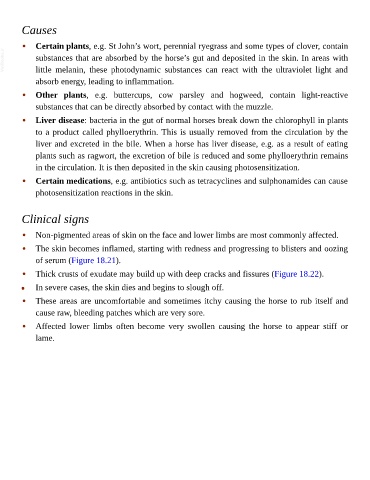Page 863 - The Veterinary Care of the Horse
P. 863
Causes
• Certain plants, e.g. St John’s wort, perennial ryegrass and some types of clover, contain
VetBooks.ir substances that are absorbed by the horse’s gut and deposited in the skin. In areas with
little melanin, these photodynamic substances can react with the ultraviolet light and
absorb energy, leading to inflammation.
• Other plants, e.g. buttercups, cow parsley and hogweed, contain light-reactive
substances that can be directly absorbed by contact with the muzzle.
• Liver disease: bacteria in the gut of normal horses break down the chlorophyll in plants
to a product called phylloerythrin. This is usually removed from the circulation by the
liver and excreted in the bile. When a horse has liver disease, e.g. as a result of eating
plants such as ragwort, the excretion of bile is reduced and some phylloerythrin remains
in the circulation. It is then deposited in the skin causing photosensitization.
• Certain medications, e.g. antibiotics such as tetracyclines and sulphonamides can cause
photosensitization reactions in the skin.
Clinical signs
• Non-pigmented areas of skin on the face and lower limbs are most commonly affected.
• The skin becomes inflamed, starting with redness and progressing to blisters and oozing
of serum (Figure 18.21).
• Thick crusts of exudate may build up with deep cracks and fissures (Figure 18.22).
• In severe cases, the skin dies and begins to slough off.
• These areas are uncomfortable and sometimes itchy causing the horse to rub itself and
cause raw, bleeding patches which are very sore.
• Affected lower limbs often become very swollen causing the horse to appear stiff or
lame.

